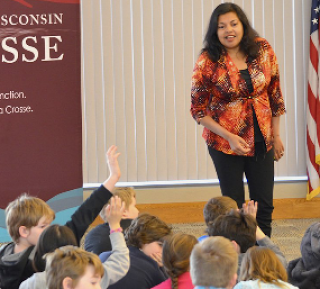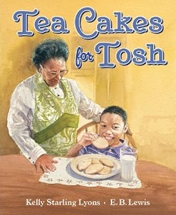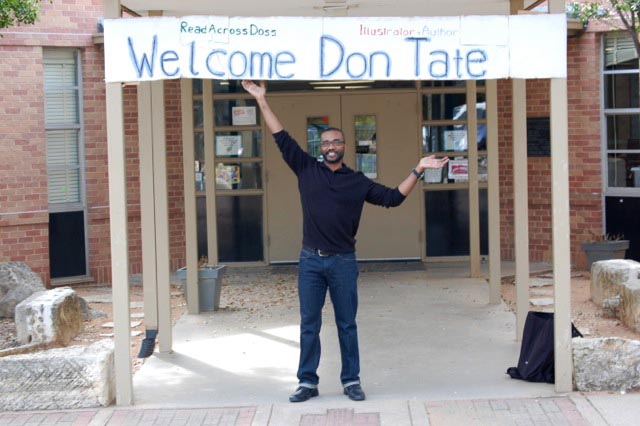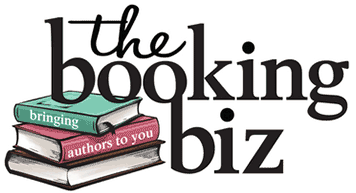Author visits have enormous benefits for students. They bring books to life and help reluctant readers become avid readers. They reinforce the lessons of teachers and librarians. They inspire children who see authors and illustrators who persevered and made their dreams come true.
But one snag in the organization of an author visit, and it can suck all the life, reinforcement and inspiration from the event.
Here are 15 tips to make sure your next school visit will run smoothly and leave your students motivated to read and succeed in everything they do.
Planning Makes Perfect

1. Communicate with the author and determine the type of program they will be delivering. Will it be a writing workshop like author Mitali Perkins‘ “How to Write a Personal Narrative…Without Losing Your Mind”? Or perhaps it will be an art demonstration like those author/illustrator Don Tate is known for. Don’t be afraid to ask an author to touch on certain elements or topics like drafting or revising or generating ideas that will help you in your classroom.
2. Determine the length of the presentation for the various grade levels. Will it be 30 minutes? 45 minutes? 1 hour? Let the author know early so they can prepare their session to fit that time.
3. Ask your author or illustrator for their AV set-up needs in advance. Will they need an easel and paper? A table for props? Will they bring their own laptop or a flash drive and use a campus computer? What about a projector or microphone? Don’t assume a microphone won’t be needed even if the room is small. Authors must often do back-to-back presentations so they can have time to work on their next books, and their voices can get tired. Also test that all your equipment is working. Make sure your speaker has everything they need so they’re comfortable and time isn’t wasted gathering or fixing equipment on the day.
4. Let the author or illustrator know in advance where he/she will be presenting (classroom, library, auditorium) and the number of students in each session. This helps the author better prepare so they can reach each student.
5. Get all the necessary paperwork completed and filed in plenty of time. Aim to have your speaker’s check available when they arrive so they don’t have to chase it down. While authors and illustrators love inspiring young readers, speaking engagements are not a promotional duty but a necessary part of their income. The preparation, travel and event itself takes time away from their families and creating their next books. Show your speakers you appreciate them by getting their payment ready on time.
Involvement Brings Excitement
6. Make sure you and your students are familiar with the author’s or illustrator’s books before they arrive. Read the book aloud together or have the children read independently. Perhaps even pair them up with reading buddies, like in author Carmen Oliver‘s picture book BEARS MAKE THE BEST READING BUDDIES. When all participants know the books before the visit, enthusiasm is higher as well as involvement. Students will ask more questions, leave with more answers, and remember the event for years to come.
 7. Check for curriculum guides for the books and share them with your teachers a month or two before the author visit. Curriculum guides help breakdown a book’s subject matter and often include exercises and games teachers can use to help children get further into the book’s world. For example author Kelly Starling Lyons offers two downloadable guides for her picture book TEA CAKES FOR TOSH, as well as a recipe for the special cakes.
7. Check for curriculum guides for the books and share them with your teachers a month or two before the author visit. Curriculum guides help breakdown a book’s subject matter and often include exercises and games teachers can use to help children get further into the book’s world. For example author Kelly Starling Lyons offers two downloadable guides for her picture book TEA CAKES FOR TOSH, as well as a recipe for the special cakes.
8. Involve your students in the event itself to get them excited. Encourage them to create posters welcoming the author or illustrator. Perhaps they can do writing and art activities to share with the speaker on the day. Author P.J. Hoover‘s TUT and THE EMERALD TABLET middle-grade novels have games that can inspire students to create their own crafts. The more children are involved with an event, the more excited and invested they’ll be on the day.
9. Offer advance book sales for your students through your favorite bookseller. Having a book of their own helps to instill a love of reading in children. If the books are available for the event, the author can sign them, personalizing for each child and making that book even more special. The children will be looking forward to getting their next one.
10. For a child, having a book signed to them right in front of them is an amazing experience that makes them feel so special. But there are times when books aren’t available in time. If book sales can’t be done in advance, ask the author to bring signed bookplates for kids who purchase a book after the author visit.
The Perfect Event

11. Designate a reserved parking spot with a sign and/or an orange pylon for your speaker. The last thing you want is for your author or illustrator to get flustered while they drive around looking for parking or have to walk far with a laptop or arms full of props for their presentation.
12. Have water available for the author. All that talking can make one parched and they’ll want to be ready to speak to every child.
13. If you are providing the author with lunch or snacks, ask about any diet restrictions. Some authors prefer to dine on their own to gather their energy for their afternoon sessions. Others want to engage with staff and students. Also consider time, whether they’ll be eating on campus or off. Make sure there will be enough time so the lunch will not be rushed. Anxiety over deadlines can kill a speaker’s energy fast.
14. Ensure teachers are present during the event and model good listening skills, with no cell phones or grading papers. Students will look to the teachers they love for examples of how they should behave. If you have taught your students signals for them to be quiet, privately share them with the author or illustrator before their first presentation in case they need to use them. Better yet, keep an eye on your students and use the signals yourself so the speaker can concentrate on making their author visit the best ever.
15. Enjoy! You’ve crossed all the t’s and dotted all the i’s, built up excitement in your students, and set everything up for the event. It’s time to share with your children the wonderful, inspiring presentation you’ve all been looking forward to.
